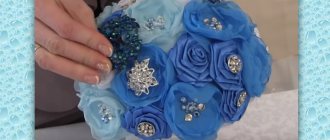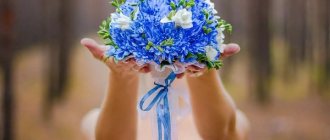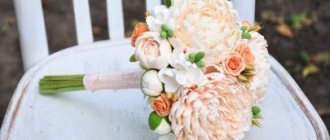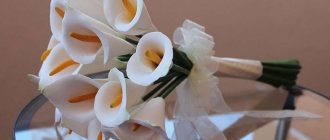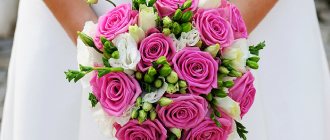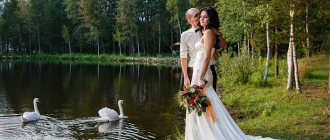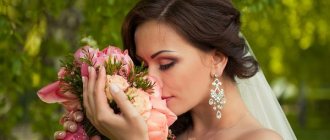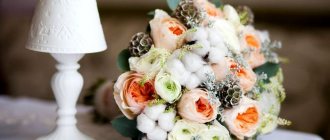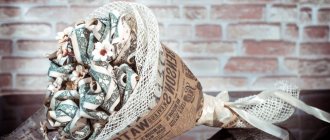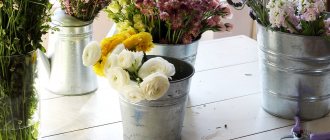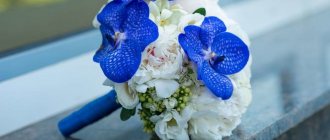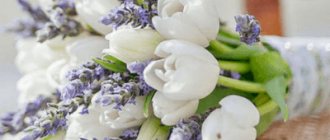Palette of tones
Most often, a blue bouquet is used at a variety of themed weddings - sea, Greek, winter.
The composition looks wonderful in complete monochrome, regardless of the specific shade , but for greater texture and creativity, another pure color is often added to the blue.
Important! The duo of blue and white remains an undisputed classic.
It is permissible to use both neighbors on the spectrum - mysterious purple and delicate blue, as well as contrasting yellow and red.

Blue-white
There are many different blue and white buds, so the florist and bride have an endless field of options.
The combination of snow-white roses and blue peonies looks great - elegance and gentle carelessness are mixed in such a composition into a magical cocktail.
For a fairly simple ensemble, it is permissible to use ordinary cornflowers and daisies, while the decor of beads of the opposite color, decorating the petals of each flower, looks very elegant.
Mono-bouquets of the same type of flowers, but in different tones, are also excellent options. A similar accessory can easily be made from chrysanthemums, orchids or hydrangeas.
Quite exquisite compositions are possible with the addition of miniature white gypsophila inflorescences to a pure blue bouquet. The overall appearance of the accessory is bright, but at the same time airy.
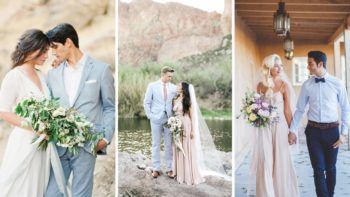
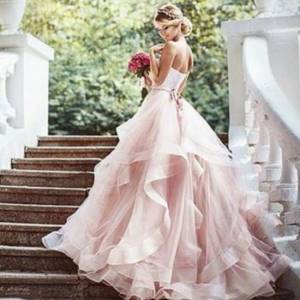
Yellow-blue
This solution looks great at spring weddings surrounded by fresh greenery and blinding sun. Clean and fresh tones create a joyful and solemn mood.
The blue and yellow lisianthus are quite interesting - a delicate, not flashy, but unforgettable composition.
Another good option is a combination of irises and peonies , especially in a loose, slightly disheveled form. This ensemble will wonderfully complement both the natural theme of the wedding and the much more chic references to Olympus and Ancient Greece.
A cascade of yellow lilies and blue orchids will turn the bride into a real fairy-tale princess.
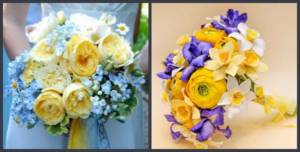
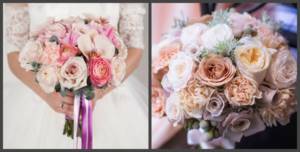
Blue-violet
If you want to add more sophistication to your bouquet, then feel free to mix these two rich colors. Such an accessory will emphasize the creative spirit and romance of the bride.
You can play with the very shape of the bouquet - an absolutely round sphere, called a pomander, which has no legs, only the ribbon by which it is hung on the wrist, looks luxurious if you make it up from lace blue and purple chrysanthemums.
Idea! Another delicate natural option is irises in a duet with white buttercups.
A more democratic option is a combination of purple tulips and blue cornflowers, wrapped in ordinary craft paper. This solution is ideal for a wedding in a rustic or eco-style.
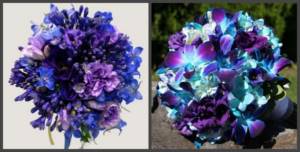

Red-blue
For lovers of bold contrasting combinations, a bright red-blue duet is also possible, while you can leave one of the colors as a solo color or divide the space between them equally.
A bouquet of blue and red roses gathered in a tight circle looks incredible. The result is a very glamorous and luxurious accessory that looks great both in the hands of a fairly young bride and an older woman.
Red roses can also be combined with other blue buds - violets, freesias, hydrangeas. At the same time, scarlet looks exquisite as small accents, for example, several bush roses randomly placed in the blue splendor.
If you want to slightly dilute such a rich combination, then add more greenery or a little white to the composition using small plants or decor.
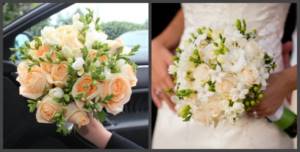
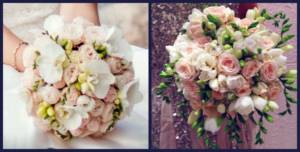
Dark blue
Blue has a wide range of shades: from quite bright classic or light blue to rich, velvety, truly royal dark blue-black.
You can choose roses that are as saturated as possible, and in nature hydrangea boasts a blue-black hue. Despite the palette, such an ensemble looks airy and vibrant due to the openwork structure of the inflorescences.
A more strict and elegant option - asters, callas, pansies, orchids. Such a bouquet will definitely be remembered by all guests and will add captivating notes to the bride’s image. Dark blue seems to be created for the use of white decor, in particular, lace ribbons or beads glued directly to the petals.
Naturally, the darker the color of the bouquet, the more carefully you need to introduce it into the overall image , for example, diluting the whiteness of the outfit with sapphire earrings, shadows, and a belt on the dress.
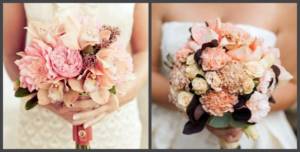
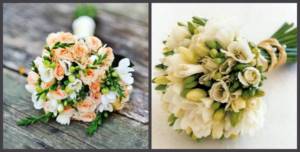
blue
A softer combination - blue with blue, symbolizes tenderness, purity and tranquility. This composition will appeal to dreamy and tender brides, as well as young ladies with blue or blue eyes.
A bouquet of irises in these two shades looks quite interesting. This bouquet is ideal for late spring and early summer.
Idea! Another charming option is a combination of freesias and peonies, while any of the flowers can be in a more delicate blue tone.
For a lush and somewhat disheveled composition, choose a duo of hyacinths and hydrangeas wrapped in craft paper. But chrysanthemums and roses in these tones will create a glamorous picture.
As for the gap between blue and cyan, it can be either very insignificant, creating a smooth soft gradient, or extremely contrasting , where blue is selected from the darkest part of the spectrum, and cyan from almost white options.
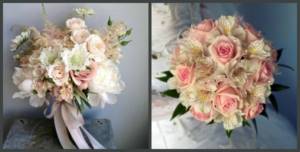
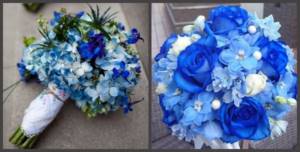
Flowers
Each flower has its own meaning in floristry, symbolizes a particular wish, and also creates a certain atmosphere. Some are great for a spring or summer celebration, others are essential for a winter wedding.
The hardiness of various plants also varies, which must be taken into account when choosing specific varieties. So, which buds and when should you use in a captivating blue composition?
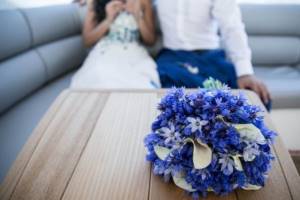
Peonies
If your wedding is planned for the period from May to July, then it is impossible to do without these large, fluffy, incredibly charming buds. Peonies are quite inexpensive, they can be grown in your own garden plot, but at the same time such flowers look excellent.
A huge palette of shades from pale blue to rich blue allows you to create a variety of compositions, and yellow, pink or white peony will perfectly dilute the blue canvas of freesias or irises.
Peonies are calm with their vase neighbors, but are vulnerable to cold, rough touches and drought. Therefore, you should not throw a bouquet of peonies to your girlfriends, but at the first opportunity, the stems should be placed in a vase, then the buds will delight you for some time after the celebration.
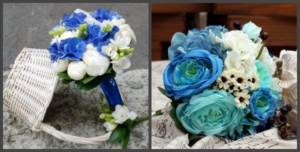
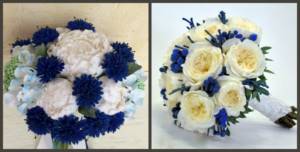
Roses
Few ceremony are complete without the queen of flowers. Roses are presented in a huge palette of varieties, from miniature bushes and elongated garden roses to the cup-shaped peony buds of the David Austin variety.
Advice! The Queen of Flowers does not particularly favor guests in a vase, so after the wedding the bouquet will have to be divided.
Unfortunately, the blue color of these exquisite plants is given artificially, but a professional florist can change the flower in such a way that it looks like a real one. Before making such a purchase, you should check whether the petals are painted - this will help avoid unpleasant situations during the ceremony itself.
Blue and blue roses create fabulous mono-bouquets, but they can also be combined with other plants. A duet of roses with peonies, lilies, chrysanthemums or freesias looks very tender.
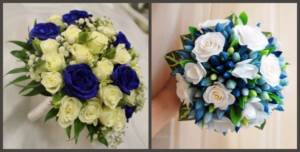
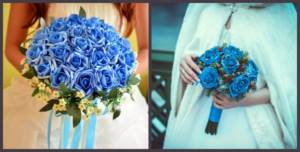
Lilies
The tremulous and sophisticated forms of lilies perfectly emphasize the tenderness and innocence of the bride. The flower looks incredible both in the classic round shape of a bouquet and in cascades.
There are no direct blue varieties in nature, but florists can add pigment to them , just like roses, and the result is an exotic, extremely charming bud.
Another option for using lilies is as a white flower on a rich blue carpet of hydrangeas, chrysanthemums or freesias. The petals of the flowers are quite large, so a professional florist is quite capable of creating such a fantastic shape from lilies as glamelia - a flower artificially glued together from different buds.
These are not the hardiest plants, so you should take care of a bouquet of lilies carefully : do not expose them to cold, drought or unnecessary touches.
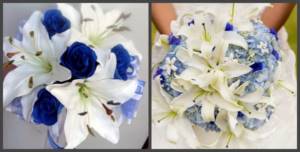
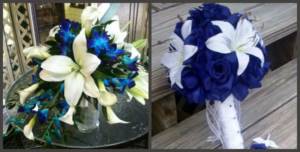
Irises
The exquisite shape of this flower seems to be created for summer and spring compositions. Irises in the language of flowers mean boundless trust and love , and look great both in mono-bouquets and as a frame for larger brothers.
An excellent solution is a combination of blue irises with white callas or tulips - the elegant elongated buds of their neighbors perfectly set off the luxurious terry petals. The usual lush greenery or disheveled twigs of white gypsophila would not be the worst duo.
Irises are very moisture-loving plants, so care should be taken to ensure that the bouquet ends up in the vase as quickly as possible.
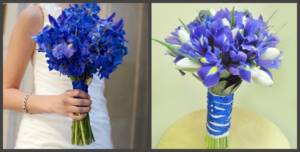
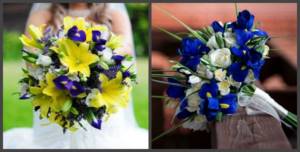
Hydrangeas
Lush round hydrangea inflorescences look magical in blue, adding the necessary volume to the composition.
A huge palette of shades allows you to create truly unique ensembles. For example, there is a variety of hydrangea that combines light blue and rich purple colors on its petals. Such inflorescences look interesting both in a mono-bouquet and in combination with roses, callas, and peonies.
For a more delicate and simple composition of hydrangeas, it is permissible to add freesias, cornflowers, gerberas, and lilacs . Hydrangeas are quite unpretentious and feel wonderful even at autumn weddings.
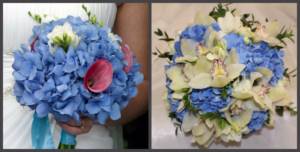
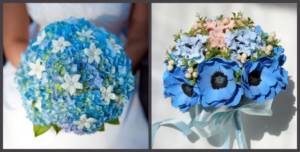
Cornflowers
Simple wildflowers are a real trend for a nature-themed wedding. A rustic, country, eco-celebration will definitely not be complete without these modest, but such captivating buds of pure rich color.
The hardy flower easily takes on any desired shape, so it is used to create a fabulous pomander - fluffy, delicate, perfectly emphasizing the charm of the bride.
Most often, cornflowers are combined with other wildflowers : daisies, clover, lily of the valley. Dried flowers, ears of corn, and a variety of greens will help add natural notes. If desired, cornflowers can be combined with more sophisticated roses, eustoma, and hydrangea.
Cornflowers dry well, maintaining their original shape, so a bouquet of these plants may well turn into an element of the interior and delight you for many years to come.
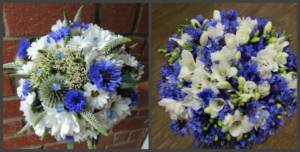
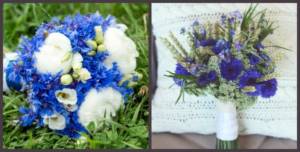
Chrysanthemums
The openwork flower, which in the east signifies fidelity and nobility, is ideal for autumn and winter weddings , because its incredible endurance can survive even the most unsuitable conditions.
A single-color pomander made of chrysanthemums, decorated with contrasting beads, looks great; fortunately, the plant’s petals are elastic enough for such decoration. If desired, you can dilute the blue with white or yellow flowers of a similar texture, for example, carnations.
Chrysanthemums also look good in a round bouquet, and spray chrysanthemums also look good in disheveled compositions with eustoma, alstroemeria, freesia, and ranunculus.
The flower goes well with almost all other gifts of flora , without trying to expel them from the vase, and stands for quite a long time after the celebration, especially if you provide it with proper care.
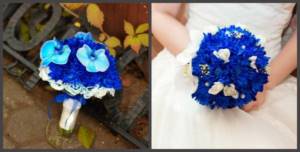
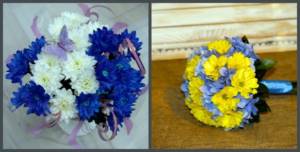
Gerberas
Playful and modest, gerberas look great in a monochrome blue shade, creating a sophisticated and simple ensemble.
Idea ! A pomander made from these plants looks elegant - florists often use original splashes of white or yellow.
Gerberas go wonderfully with elegant roses, cute daisies, daffodils, and tulips. A flaming single gerbera on a dense round bouquet of cornflowers or hydrangeas will become a magical accent. An extremely elegant and original combination - gerberas and large garden roses, with one of the flowers becoming deep blue and the second snow-white.
The plant has good endurance, and therefore is able to please brides both in winter and summer , and also behaves quite well in a vase with its neighbors.
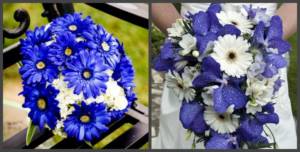
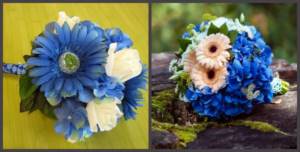
Hyacinths
Hyacinths are a little similar to hydrangea - the same airy and voluminous inflorescences, but not round, but elongated upward.
Because of its stunning appearance, the flower quite organically fits into the luxurious company of roses and lilies, and into the delicate wildflower.
A mono-bouquet of this plant, wrapped in craft paper or antique darkened lace, looks unforgettable.
A very delicate duet is obtained from hyacinths and tulips , both already in bloom and those still remaining in buds. This composition is perfect for spring and a very young, dreamy bride.
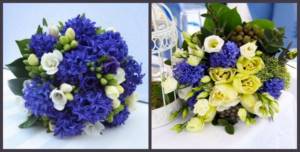
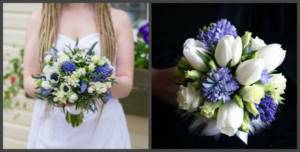
Fruits, berries and fruits
Since a blue bouquet is most often used to create a unique accent, it is advisable to add a variety of suitable decor to it:
- Ordinary branches painted blue look very interesting - they can be decorated with decorative pendants or lace;
- In autumn, blue berries are often used in the composition - blueberries, sloe, honeysuckle, grapes;
- Some ensembles also allow the presence of fruits - plums or exotic figs.
Such gifts of nature look worthy both with delicate lush petals of peonies or hydrangeas, and with exquisite royal petals of roses, orchids or alstroemerias.
Fresh herbs will be a good addition ; in addition, it will save the light petals if the berries or fruits suddenly give juice.
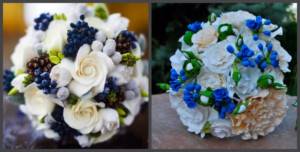
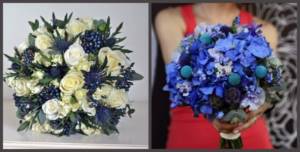
How to do it?
When creating a bouquet with your own hands, it is important to listen to the recommendations of experienced florists.
- The main rule when composing a bouquet with blue flowers is: if the bride’s dress is elegant and lush, the composition should be modest.
- It is advisable to make the bride's bouquet of blue flowers with short stems. Protruding greenery does not always harmonize with the entire composition.
- It is necessary to choose flowers depending on the time of year.
- It is important that the flowers are fresh, strong, without the presence of coloring elements, such as pollen, like lilies. Roses with thorns can damage the dress or scratch the bride's hands.
- Before creating, it is recommended to practice on those colors that are on hand or sold in the store.
When choosing a composition, you can consult a florist who will suggest the right solution and encourage you to create an incredible bouquet. It is important to clarify which shades can be combined with each other.
If you don’t know a florist, it is recommended to go shopping and look at the accessories on offer. It is possible that the composition you see will push and inspire you to create a beautiful wedding bouquet with your own hands.
Bouquet options for the bride
- Option with a portaquet. Quite a popular design method. Looks good and plays for a long time. You can start creating a masterpiece only after preliminary training. The portbuket holder is represented by a foam ball with a plastic base. First, the foam rubber is moistened with water, and then the flowers are inserted one by one. To complete the composition, the base is covered with ribbons or lace. It is not recommended to throw such a bouquet into the air, since during the “flight” all the flowers will simply fall out of it.
- Ensemble on a wire. The flowers are collected together and a wire is inserted into each stem to make it strong.
- Composition on stems. A very simple composition to perform. It is considered the most affordable option for creating a wedding bouquet. It's not difficult to make. You need to take roses or hydrangea, put them together, trim off the excess stems and tie them with decorative ribbon. Then beads, rhinestones, brooches and other accessories are used for decoration.
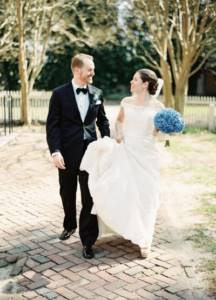
A blue bouquet is the best solution for the bride. If the wedding day is scheduled for winter, the wedding bouquet will look perfect. The florist will also recommend a blue design, which will be complemented by the bride’s snow-white cape and the groom’s black suit. If you want to dilute the heavenly color with other shades, you can include a yellow, soft pink or green flower.
Matching the wedding dress, season, style of celebration
First of all, such a bright composition will be appreciated by calm and confident girls , who nevertheless know how to dream and love romance.
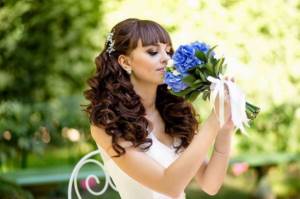
Celestial shades combine perfectly with blue-eyed beauties - the accessory will highlight the enchanting eye color, adding depth and richness to it. Due to its versatility and existence in both warm and cool tones, blue will wonderfully highlight any color type.
The color will also appeal to girls who want to create an interesting, memorable accent , but those who don’t really like flashy tones, because blue, despite all its strength, is quite soft and elegant.
A blue bouquet is suitable for a wedding planned for any season:
- in summer the shade will create a breath of freshness, dispersing the heat;
- in spring it will reveal its radiant, youthful and playful side;
- in the fall it will remind you of peace and well-being;
- in winter it will wonderfully dilute the snow-white surrounding monochrome.

Guidelines for choosing plants
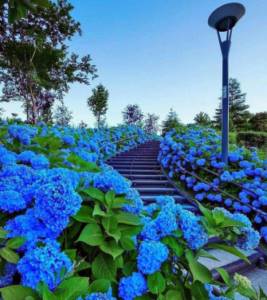
All flowers that are grown in open areas are divided into 3 groups:
- annuals;
- two-year-olds;
- perennial.
The first category includes crops that can completely go through all stages of life in one season. They develop successfully, decorate themselves with inflorescences, pollinate and bear fruit. And in the fall, they bear seeds and disappear forever. Despite this, annuals are very popular with designers. The wealth of varieties allows you to create unique compositions every year.
Immediately after flowering, annual crops can be removed and a new flower bed can be arranged.
In two-year-old plants, buds appear only in the next season. Some specimens live longer than expected, which makes gardeners very happy. However, perennials are considered the most valuable “company”. They retain their original decorative properties for decades. Most perennials have leaves and branches that die. The underground part resumes vegetation as soon as suitable conditions are created. To choose suitable flowers for your flowerbed, you need to get to know them. Let’s open and leaf through the “book” of bright plants for the garden.
Important Tips
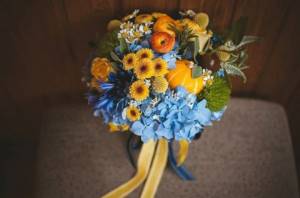
- The bouquet must be included in the overall concept of the holiday and the image of the bride. To do this, you should add a certain number of elements in tone - jewelry, makeup, nail polish, handbag, table or hall decor;
- A fabulous ensemble will turn out if the groom’s suit is in blue tones. As a last resort, a boutonniere that echoes the bouquet is possible;
- In poor lighting, blue and green inevitably blend together. To prevent this from happening, and for your photos to delight you with clear lines, add a little white or light blue. Such a solution will improve the texture of the accessory and make it much more interesting;
- Don’t be afraid to add additional colors - purple, yellow, red, blue, but remember about harmony - it is not recommended to use more than three pure shades;
- A good idea is to add seasonal elements to the bouquet. In the spring, an unforgettable picture will be created by fluffy willow twigs, in the summer - ears of corn just beginning to swell, in the autumn - a variety of fruits, berries and fruits, in the winter - weightless clouds of cotton, moss, bluish needles;
- Any manipulations with the shape, color and decoration on the buds themselves reduce the lifespan of the flowers. Take this into account if you want, for example, glamelia of blue roses with pearls.
Idea! In difficult situations, artificial flowers made of silk, felt or paper will come to the rescue. They definitely won’t wither even during the longest day.
Boutonniere for the groom
This accessory is used not only to decorate the groom’s suit, but also to decorate the clothes of witnesses. The bouquet is attached to the top of a man's outfit (pocket, lapel), thus emphasizing the special status of the participants in the celebration. You can use a boutonniere to communicate a man’s status to others. For married guys, the bouquet is attached to the right, and for unmarried guys - to the left. Such decoration will help the groom look elegant, but less formal.
READ
A blue wedding bouquet with peonies is a symbol of femininity and tenderness
It is important to purchase the right boutonniere. The accessory must:
- match the girl’s image (same colors or same color scheme);
- complement the young bouquet (if there are decorative berries and herbs, a boutonniere can be created only from these components);
- match the image of the man himself (if he is wearing a blue suit, you should not buy the same boutonniere; you should look for bouquets and a neckpiece of the same color);
- be persistent (it is better to make an accessory from seasonal flowers that will not wither by the end of the holiday).
Photo
A bright accent of the celebration will be the bride's bouquet in blue. Several ideas are presented in the photo:

